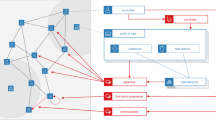Abstract
In a supply chain, the distorted demand information when it goes upstream is commonly known as the bullwhip effect. In this paper, the impact of demand substitution on the bullwhip effect in a two-stage supply chain is investigated. In our model, a single retailer observes inventory levels for two products, among which product 1 can be used to substitute product 2. The retailer places orders to a single manufacturer following an order-up-to inventory policy and uses a simple moving average forecasting method to estimate the lead-time demand. The customers’ demands are modeled by an autoregressive process. By analyzing the bullwhip effect in such settings, quantitative relations between the bullwhip effect and the forecasting method, lead time, demand process, and the product substitution are obtained. Numerical results show that demand substitution can reduce the bullwhip effect in most cases.










Similar content being viewed by others
Notes
The explicit technique details are shown in the Appendix.
The explicit technique details are shown in the Appendix.
Chen et al (2000a) oversimplified the situation to claim that for ρ < 0 the lower bound on the increase in variability will be large for odd values of p than for even values of p.
References
Agrawal N, Smith SA (2003) Optimal retail assortments for substitutable items purchased in sets. Naval Res Logist 50(7):793–822
Bassok Y, Anupindi R, Akella R (1999) Single-period multiproduct inventory models with substitution. Oper Res 47(4):632–642
Bitran G, Dasu S (1992) Ordering policies in an environment of stochastic yields and substitutable demands. Oper Res 40(5):177–185
Chen F, Drezner Z, Ryan JK, Simchi-Levi D (2000) Quantifying the bullwhip effect in a simple supply chain: the impact of forecasting, lead times, and information. Manage Sci 46(3):436–443
Chen F, Ryan JK, Simchi-Levi D (2000) The impact of exponential smoothing forecasts on the bullwhip effect. Naval Res Logist 47(4):269–286
Drezner Z, Gurnani H (2000) Deterministic hierarchical substitution inventory models. J Oper Res Soc 51(1):129–133
Drezner Z, Gurnani H, Pasternack BA (1995) An eoq model with substitutions between products. J Oper Res Soc 46(7):887–891
Forrester J (1958) Industrial dynamics, a major breakthrough for decision makers. Harvard Bus Rev 36:37–66
Fuller JB, O’Connor J, Rawlinson R (1993) Tailored logistics: the next advantage. Harvard Bus Rev 71(3):87–98
Gilbert K (2005) An ARIMA supply chain model. Manag Sci 51(2):305–310
Karaesmen I, van Ryzin G (2004) Overbooking with substitutable inventory classes. Oper Res 52(1):83–104
Lee HL, Padmanabhan V, Whang S (1997) The bullwhip effect in supply chains. MIT Sloan Manage Rev 38(38):93–102
Lee HL, Padmanabhan V, Whang S (1997) Information distortion in a supply chain: the bullwhip effect. Manage Sci 43(4):546–558
Liu H, Wang P (2007) Bullwhip effect analysis in supply chain for demand forecasting technology. Syst Eng Theory Practice 27(7):26–33
McGillivray AR, Silver EA (1978) Some concepts for inventory control under substitutable demand. Inf Syst Oper Res 16(1):47–63
Metters R (1997) Quantifying the bullwhip effect in supply chains. J Oper Manage 15(2):89–100
Netessine S, Rudi N (2003) Centralized and competitive inventory models with demand substitution. Oper Res 51(2):329–335
Parlar M, Goyal S (1984) Optimal ordering decisions for two substitutable products with stochastic demands. OPSEARCH 21:1–15
Rajaram K, Tang CS (2001) The impact of product substitution on retail merchandising. Eur J Oper Res 135(3):582–601
Ryan JK (1997) Analysis of inventory models with limited demand information. PhD thesis, Northwestern University, Evanston, IL
Zhang X (2004) The impact of forecasting methods on the bullwhip effect. Int J Prod Econ 88(1):15–27
Author information
Authors and Affiliations
Corresponding author
Appendix
Appendix
1.1 The derivation process of E(Dt,i) and Var(Dt,i)
When the autoregressive demand process is stationary, we have E(Dt,i) = E(Dt−1,i) = E(Dt−2,i) = ⋯ = E(D i ) and Var(Dt,i) = Var(Dt−1,i) = Var(Dt−2,i) = ⋯ = Var(D i )
1.2 The derivation process of the further expression of qt,1
1.3 The derivation process of the expression of Var(qt,1)
To further simplify Equation 9, we need to calculate Cov(Dt-1,1, Dt-p-1,1) and \(Cov(D_{t-1,1},\hat{\sigma}_{t,1}^{L})\)
Note that \(Cov(\frac{\mu_1}{1-\lambda},D_{t-p-1,1})=0\), because \(\frac{\mu_1}{1-\lambda}\) is a constant (Cov(X,a) = 0). \(Cov(\epsilon_{t,1},D_{t-p-1,1})=0\), because \(\epsilon_{t,1},D_{t-p-1,1}\) are independent from each other.
Ryan [20] proved the following result that can further simplify Equation 9. Assume the customer demands seen by a retailer are random variables of the form as \(D_{t}=\mu+\rho D_{t-1}+\epsilon_{t}\) and the error terms \(\epsilon_t\) are i.i.d. from a symmetric distribution with mean 0 and variance σ2. Let the estimate of the standard deviation of forecast error of lead-time demand be \(\hat{\sigma}_t^L=C_{L,\rho}\sqrt{\frac{\sum_{i=j}^p(D_{t-j}-\hat{D}_{t-j})^2}{p}},\) then
By applying the results of Equation 28 and Equation 29, the expression about Var(qt,1) can be further simplified.
1.4 The derivation process of the further expression of qt,2
1.5 The derivation process of the expression of Var(qt,2)
Now we calculate Cov(Dt-1,2, Dt-p-1,2)
We assume that the covariance is only affected by the number of periods which are taken into consideration. That is
Thus
Substitute the above equation to Eq. 17, we have
Rights and permissions
About this article
Cite this article
Li, X., Song, L. & Zhao, Z. Quantifying the impact of demand substitution on the bullwhip effect in a supply chain. Logist. Res. 3, 221–232 (2011). https://doi.org/10.1007/s12159-011-0060-y
Received:
Accepted:
Published:
Issue Date:
DOI: https://doi.org/10.1007/s12159-011-0060-y




